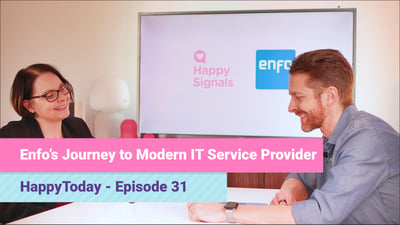HappySignals works in conjunction with ServiceNow, combining HappySignals Experience Data with ServiceNow’s Operational data. This helps support organisations and the whole ecosystem to reach their desired outcomes, including helping customers to work more efficiently, as well as making end users happier with the services they receive.
For example, you are able to identify from the experience data that people are losing productivity, and from the operational data that it is due to certain channels, services or that something has happened within the process. This means combining experience data and operational data is crucial in order to bring the right changes for your end-user.
HappySignals helps all parties, working with ServiceNow through 4 different aspects:
- Transparency of experience data
- Trust with all stakeholders, C-level, Service Desk, Partners and Vendors
- Focus, so the ability to agree based on data what must be improved/changed
- Outcomes that make employees happier and more productive
Let's explore these four aspects into greater detail.
Transparency
HappySignals gathers data of end-user satisfaction and end-user experience through our ‘out-of-the-box’ surveys. The surveys are ready-made for each process, meaning no time wasted on learning to become a survey designer, creating quick deployment.
Having the data and not sharing it in real-time with everyone is usually the biggest issue. Using HappySignals, this data is provided to all stakeholders, such as CIO, IT Director, partners, service owners, service desk managers and agents - gaining a greater transparency for all parties on the end-users’ opinions and feedback. Also the data is in an understandable format and doesn't require expertise on accessing ServiceNow's reporting tools, which matters if you want to engage C-level, business stakeholders or non-technical users in your organisation.
The surveys created by HappySignals gain high response rates from users due to the way the surveys are delivered. As well as this, HappySignals users also gain access to the The Global IT Experience Benchmark allowing organisations to compare their scores with other HappySignals users.
Trust
Through this transparency will create trust between partners, as everybody begins to share the same problem, access the same data, as well as trusting each other to help working together to fix the problem. This will create a shift in how everybody begins to work.
Through HappySignals Instant Feedback Loops, users are able to give direct feedback on what was wrong and what has impacted their experience. This information needs to be real-time and inside the tool agents are already using. So in this case on their ServiceNow homepage, which is why HappySignals widgets make it easy to engage agents.
Focus
When you begin to recognise the certain areas that are not working within your service desk or management, you begin to share a common issue with your stakeholders. This means that you can start to focus on this issue you are solving.
This may mean taking the data provided and working out that you may need to introduce a new tool or automation into a service that the end-users are unhappy with.
By using HappySignals Live Screens you will be able to see real-time data on what is affecting the experience of the end-users. Paired with HappySignals Real-time Analytics tool you can also begin to focus on the different areas that will need improving, justifying ways to effectively change your end-users experience, creating a productive and happy outcome.
Outcome
From the data received, you will be able to use the data to work out what you need to change and improve as well as where you could potentially invest or install other services to help deliver the change.
As well as this, part of the outcome is to show if the solution has been successful. Through the continuous data gathering tools and presenting results, you will be able to see the reduced productivity loss.
Delivering outcomes should always be seen from how it will benefit the end-users and increase productivity or happiness with their service desk or services. For example if IT was planning on using a certain automation tool in order to automate certain services, then it should be done with the aim on how to increase the end users productivity. A good example of this is using Agent Intelligence to help and reduce the ticket reassignment counts.
It should also be from an employee perspective instead of an IT perspective as changes should be made to solve the employees problems - employees experiences. Like our customer Avanti West Coast puts it "Happiness is all that matters".
From looking at it this way it will generate happy employees as it is solving their problems from their perspectives. This also means you will be able to justify future project and future changes to other people in the organisation on improving and changing certain services.
These principles can also be used when you are thinking how not to fail with your Digital Transformation projects or how to justify automation cases. Additionally, HappySignals creates IT Support profiles for your employees, which helps you justify rollouts of Self-Service Portals, Virtual Agent chatbots and Knowledge Bases.
HappySignals is available at the ServiceNow Store.
To Learn more, watch our product demo.
Or watch on-demand webinar on how Human-Centric IT supports your IT Initiatives



